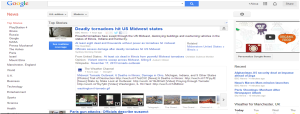Google News: A News Aggregator For Users
 With so many news sources out there, it’s hard to keep on top of a story whilst simultaneously getting all the angles. Google News aims to break this barrier and offer users a news aggregator that puts the story first, and then offers links to as many different sources as possible to avoid dependence on a single, biased news organisation.
With so many news sources out there, it’s hard to keep on top of a story whilst simultaneously getting all the angles. Google News aims to break this barrier and offer users a news aggregator that puts the story first, and then offers links to as many different sources as possible to avoid dependence on a single, biased news organisation.
 Google News became available in beta stage in 2002, and was developed after an idea by Krishna Bharat, a Google research scientist.
Google News became available in beta stage in 2002, and was developed after an idea by Krishna Bharat, a Google research scientist.
The service was taken out of beta in 2006, but Google continued to work towards making the experience smoother and more accessible.
A series of updates was introduced in 2011, when a new layout was presented and Google News Badges were launched.
The website also undertook a major structural overhaul, with the Sci/Tech section being split into two separate science and technology tags. This split has yet to occur in some foreign language version of the site.
Google News offers content in 28 languages, covering over 60 regions worldwide. Its international dimension lead to the service coming under fire after choosing not to include some news sources into its results for Chinese users, as they could not be accessed from China. This move attracted comments that Google was too tolerant of the Chinese government’s censorship and control over internet access in the country.
Overall, Google News links to content from over 25,000 publishers, allowing users to personalise their experience by choosing which topics they’re more interested in. They also have the option to set up alerts and follow the latest developments, which they can do either by receiving one overview email a day, a sort of readers’ digest, or by getting constant updates as a story progresses and more and more news articles are published.
Google News also includes a Top Stories section in its left sidebar, which shows users the main topics of discussion and breaking news in the world. A comparison can be made to Twitter’s trending topics, although these are not always news related and sometimes include sponsored content.
 Google News displays stories for the last 30 days, although a comprehensive archive is available to search. The archive was released in 2006, and included stories going as far back as 200 years ago for some of its sources. In 2008, Google started adding content from scanned newspapers, and the New York Times was fully available dating back to its beginnings in 1851. In the first few years of the archive’s existence, Google included more advanced search options, and a timeline view to organise archived content.
Google News displays stories for the last 30 days, although a comprehensive archive is available to search. The archive was released in 2006, and included stories going as far back as 200 years ago for some of its sources. In 2008, Google started adding content from scanned newspapers, and the New York Times was fully available dating back to its beginnings in 1851. In the first few years of the archive’s existence, Google included more advanced search options, and a timeline view to organise archived content.
As time passed, the timeline was discontinued and many changes were made to the search function making it less accessible. This caused quite a stir among its users, who were unhappy links to the archive were removed from the front page and now additional effort was required from people to wade through the archive’s content. Google further demonstrated its lost interest in developing the project in 2011 when it stopped scanning old newspapers and decided to refocus and offer new media organisations the ability to sell subscriptions through Google News.
Among its many sources, Google News offers content from news agencies, although copyright issues have made this a problem. In 2005, Agence France-Presse (AFP) sued Google over its use of their links and photos without permission, although the conflict was resolved and the service still offers access to AFP content. In contrast, Google News was paying for Associated Press (AP) content in the past, but stopped in 2009 – as a result, AP content is no longer displayed on the site.
